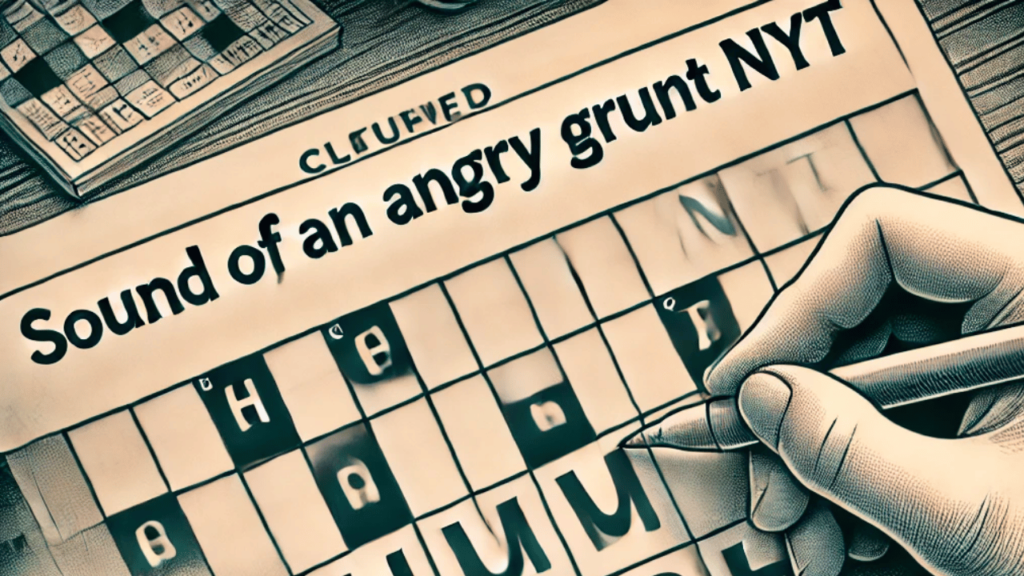Introduction:
We’ve all heard it – that guttural, primal sound that erupts when someone’s frustration boils over. It’s the sound of an angry grunt nyt, a universal language of displeasure that transcends words. But have you ever stopped to wonder about the science behind this raw expression? What makes us grunt when we’re angry, and what does it say about our evolutionary past?
Understanding the “Sound of Angry Grunt”
Picture this: You’re stuck in bumper-to-bumper traffic, late for an important meeting. The car in front of you cuts you off, and before you know it, a deep, guttural sound escapes your throat. That, my friends, is the angry grunt in action.
But what exactly is an angry grunt? It’s more than just a noise – it’s a complex, non-verbal form of communication that speaks volumes about our emotional state. It’s short, it’s low-pitched, and boy, does it pack a punch!
The Evolutionary Origins of the Angry Grunt
Now, let’s hop in our time machine and travel back to our caveman days. Our ancient ancestors didn’t have fancy words to express their anger. Instead, they relied on primal sounds to communicate danger, frustration, or displeasure.
These grunts served as a warning system, a way to establish dominance without resorting to physical violence. Think of it as the original “back off” signal. Fast forward to today, and we’re still using this ancient form of communication, albeit in more modern contexts.
Psychological Underpinnings of the Angry Grunt
So, what’s going on in our heads when we let out an angry grunt? It’s like a pressure cooker of emotions, really. When words fail us, or when we’re too angry to form coherent sentences, our brain takes a shortcut. It bypasses the language centers and goes straight for the primal vocalization.
Cultural Variations in the Expression of Anger
Now, here’s where it gets really interesting. While the sound of an angry grunt nyt is universal, how it’s perceived and expressed can vary wildly across cultures. In some societies, letting out a good, hearty grunt when you’re ticked off is perfectly acceptable. In others, it might be seen as rude or uncivilized.
Take Japan, for instance. Known for its emphasis on harmony and restraint, open expressions of anger, including grunts, are often frowned upon.
The Anatomy of a Grunt
Let’s get a bit technical for a moment. What’s actually happening in our bodies when we grunt in anger? It’s like a full-body workout, honestly.
First, your lungs fill with air. Then, your vocal cords tighten, and your larynx drops. As you expel the air, it passes through this tightened passage, creating that distinctive, low-pitched sound. The intensity of your grunt – its volume, duration, and pitch – can all indicate just how steamed you really are.
Evolutionary Roots
Our ability to grunt in anger is like a living fossil, a remnant of our prehistoric past that’s still with us today. Before we developed complex language, grunts were a crucial part of our communication toolkit.
Early humans used grunts to convey a range of emotions and needs. An angry grunt could warn of danger, express displeasure with a tribe member, or signal frustration during a hunt. It’s a reminder that beneath our sophisticated exteriors, we’re still very much connected to our primal roots.
Practical Applications
Understanding the sound of an angry grunt nyt isn’t just a fun bit of trivia – it has real-world applications. Imagine you’re a teacher dealing with a frustrated student, or a manager handling a disgruntled employee. Being able to recognize and interpret these non-verbal cues can be a game-changer.
The “Sound of Angry Grunt NYT”: A Case Study
The New York Times, always at the forefront of cultural analysis, has delved into the world of angry grunts. Their coverage offers a fascinating lens through which to view this primal expression.
The Role of Media in Shaping Perceptions of Anger
Media portrayals, including those in the NYT, play a huge role in how we perceive and understand angry grunts. They can contextualize these sounds, helping us see them not just as random noises, but as meaningful forms of communication.
Analysis of Key Articles and Features
The NYT has covered angry grunts in a variety of contexts, from political debates to Broadway performances. One particularly interesting piece explored the use of grunts in tennis, analyzing how these vocalizations affect player performance and audience perception.
Another article delved into the world of voice acting, discussing how voice actors use grunts to convey complex emotions in animated characters.
The Science Behind Angry Vocalizations
Now, let’s put on our lab coats and dive into the science behind these angry sounds. Researchers have been studying angry vocalizations for years, and their findings are pretty mind-blowing.
Physiological Mechanisms
When you grunt in anger, your body goes through a series of rapid changes. Your heart rate increases, your blood pressure rises, and stress hormones flood your system. It’s like your body is preparing for a fight, even if the threat is just a traffic jam or a stubbed toe.
Interestingly, the act of grunting can also provide a kind of release valve for these physiological changes. It’s why letting out a good “ARGH!” can sometimes make you feel better – you’re literally venting some of that pent-up physical tension.
Psychological Mechanisms
Psychologically, angry grunts are fascinating. They often occur when we’re feeling overwhelmed or out of control. The grunt becomes a way to assert ourselves, to make our presence known when words fail us.
Some psychologists theorize that grunting in anger is a form of emotional regulation. By releasing some of that anger in a controlled, vocal way, we’re actually helping to manage our emotions and prevent them from escalating further.
Social and Interpersonal Dynamics
In social situations, an angry grunt can be like dropping a bomb. It immediately changes the dynamic, signaling to others that something’s not right. How people respond to this signal can greatly influence the outcome of the interaction.
For example, in a heated argument, an angry grunt might serve as a warning sign, prompting others to back off or change their approach. In a supportive environment, it might elicit concern and offers of help. The context and relationship between the grunter and the listener play a huge role in how these vocalizations are interpreted and responded to.
The Impact of Angry Grunts on Human Behavior
Angry grunts don’t just affect the person making them – they can have a ripple effect on everyone in earshot. Let’s explore how these primal sounds influence our behavior and interactions.
The Role of Angry Grunts in Conflict and Resolution
In conflict situations, an angry grunt can be like gasoline on a fire or a splash of cold water – it all depends on how it’s perceived and handled. Sometimes, a grunt can escalate tensions, signaling that someone is too angry for rational discussion. Other times, it can actually defuse a situation by allowing for a release of tension without resorting to more aggressive actions.
The Influence of Angry Grunts on Group Dynamics
In group settings, angry grunts can have a powerful effect. They can create a sense of unease or tension, potentially disrupting group cohesion. On the flip side, they can also foster a sense of solidarity if group members perceive a common source of frustration.
Managing and Mitigating the Effects of Angry Grunts
So, what do we do when faced with an angry grunter, or when we feel the urge to grunt ourselves? Managing these primal expressions is key to maintaining positive relationships and effective communication.
For the grunter, techniques like deep breathing or counting to ten can help manage the impulse to vocalize anger. For those on the receiving end, responding with empathy and open communication can help address the underlying issues causing the frustration.
Psychological Insights
Diving deeper into the psychology of angry grunts reveals some fascinating insights into human nature. These vocalizations often serve as a window into our deeper emotional states.
For instance, a person who frequently resorts to angry grunts might be struggling with expressing their emotions verbally. The grunts become a sort of pressure release valve for pent-up feelings. Understanding this can lead to better self-awareness and emotional regulation.
Social Context and Interpretation
Context is king when it comes to interpreting angry grunts. The same sound can have wildly different meanings depending on where and when it occurs.
A grunt of frustration during a difficult workout might be seen as a sign of determination and effort. The same grunt in a quiet library would likely be interpreted very differently! Cultural norms, personal relationships, and specific situations all play a role in how we perceive and respond to these primal vocalizations.
The Role of Media and Pop Culture
Media and pop culture have a huge influence on how we view and use angry grunts. Think about iconic movie scenes where a character lets out a primal yell of rage. These portrayals shape our understanding of how anger is expressed and perceived in society.
TV shows, movies, and even video games often exaggerate angry vocalizations for dramatic effect. While this can be entertaining, it’s important to remember that real-life expressions of anger are usually more nuanced and complex.
The Sound of Angry Grunt in Popular Culture
Angry grunts have become a staple in various forms of media and entertainment. They’re used to convey intense emotions, create dramatic tension, or even provide comic relief.
Depictions of Angry Grunts in Media and Entertainment
From the Incredible Hulk’s iconic roars to Homer Simpson’s frustrated “D’oh!”, angry grunts are everywhere in pop culture. These exaggerated depictions can be highly entertaining, but they also shape our expectations of how anger should be expressed in real life.
Video games, in particular, make extensive use of angry grunts to convey character emotions and intensify the gaming experience.
The Influence of Media on Public Perceptions of Anger
Media portrayals of angry grunts can have a significant impact on how society views the expression of anger. Responsible reporting and realistic depictions can promote understanding and empathy. However, sensationalized or stereotypical portrayals may reinforce negative attitudes about anger expression.
It’s crucial for media consumers to think critically about these depictions and understand the difference between dramatized anger for entertainment and real-world expressions of frustration.
Practical Applications of Understanding Angry Grunts
Believe it or not, understanding angry grunts can be incredibly useful in daily life. Let’s explore some practical applications of this knowledge.
Enhancing Communication and Emotional Intelligence
By tuning into these non-verbal cues, we can become better communicators. Recognizing when someone is too frustrated for words can help us adjust our approach and avoid escalating conflicts. It’s like having a superpower for reading emotions!
In professional settings, this awareness can be particularly valuable. Imagine being able to sense when a colleague or client is becoming frustrated before they even say a word
Applications in Conflict Resolution and Negotiation
For those in fields like law, diplomacy, or business negotiation, understanding angry grunts can be a game-changer. These vocalizations often signal that tensions are rising and a new approach may be needed.
Skilled negotiators might use this knowledge to know when to call for a break, when to change tactics, or when to address underlying emotional issues that are hindering progress.
Implications for Mental Health and Well-being
Understanding and managing our own angry grunts can be a valuable tool for mental health. Learning to recognize the urge to grunt as a sign of rising frustration can help us implement coping strategies before anger gets out of hand.
Conclusion
As we’ve seen, the sound of an angry grunt nyt is far more than just a noise – it’s a fascinating window into human psychology, evolution, and communication. From our caveman ancestors to modern-day New Yorkers stuck in traffic, this primal vocalization has played a crucial role in expressing our frustrations and asserting ourselves.
Understanding the science behind angry grunts can enhance our emotional intelligence, improve our relationships, and even contribute to better mental health.
FAQs
1. What exactly causes an angry grunt?
Angry grunts are typically triggered by sudden frustration or stress. They’re often an instinctive response when we’re too angry or overwhelmed to form words.
2. Do angry grunts mean the same thing in all cultures?
Not necessarily. While the basic sound might be similar, cultural norms heavily influence how angry grunts are perceived and when they’re considered appropriate.
3. Can angry grunts ever be beneficial?
Surprisingly, yes! Grunting can provide a physical release for tension and can sometimes prevent anger from escalating further. It’s like a pressure valve for emotions.
4. How should I respond if someone grunts angrily at me?
Stay calm and try to understand the underlying emotion. Sometimes, acknowledging their frustration can help de-escalate the situation. When in doubt, give them some space.
5. Are there any techniques to control angry grunting?
Deep breathing exercises and mindfulness techniques can help manage the impulse to grunt in anger. Recognizing your triggers is also key to controlling these vocalizations.






